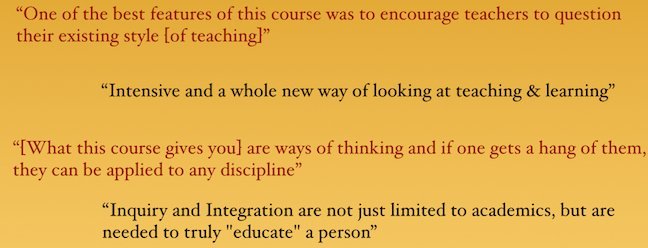
Innumerable articles and tea-time discussions on education focus on a common problem — our education gives us knowledge but almost no ability to actually discover new knowledge, or make use of it. Many solutions are being implemented— introducing activity oriented textbooks, increased emphasis on learning by doing (here), integrating science teaching and research (here and here) etc.
A team of old and young educationists (team ThinQ) is following a different and a more fundamental path. Our education largely ignores the process of discovery. We teach science as a ‘finished product’, and largely sideline the actual process of discovery. Similarly, mathematics, history, economics are taught as “subjects”, but not as a process of discovering patterns and relations between quantities (mathematics), what happened in the past (history), or the laws of wealth (economics). The process of discovery is fundamental to all knowledge, but is never taught to us. This brings us to the solution proposed by team ThinQ: a focus on inquiry and integration. As the names suggests, their approach aims to combine inquiry with integration (the process of combining inquiry with knowledge of various disciplines). To steer our education towards these, ThinQ has come up with a detailed and rigorous online course meant for practicing or would-be teachers, educators, or anyone else who shares this cause and passion. In this article, we describe the course that was run in 2016, and will be offered again starting May 2017.
In the 3rd edition of the course in 2016, about a hundred participants were enrolled. They included teachers and principals, apprentices and experienced educationists, the interested and concerned parents. Altogether a diverse mix, it was perfect for the exchange and churning of ideas. The course progressed via a series of reading assignments and videos, called Learning Triggers. Every alternate week was assigned for reading and reflection, and the following week for an online discussion. One part of every assigned reading was drawn from a book on inquiry by experienced educationists of the ThinQ team, Tara Mohanan and KP Mohanan. Typically one or two elements of a rational inquiry — observing, describing, classifying, generalizing, defining, reasoning, justifying, debating etc, were introduced in each reading. These elements and their nuances were demonstrated by using examples and exercises that participants could reflect over, engage with, and even use in their classes. The readings were accompanied by videos of the same ideas being discussed with high school students in a classroom setting. After reading and reflecting on the given material, participants were asked to submit their thoughts as written assignments. In the subsequent week, all responses were made available to the entire group. The phase of alternating reading assignments and online discussions was followed by a face to face interactive workshop for select participants.
Participants often asked questions about concepts that were difficult to grasp, some were concerned whether too much skepticism was a good idea, and some wanted to know how to teach inquiry when students come with varying backgrounds and inclinations. The ThinQ team responded to issues of common interest and an online discussion then ensued.
For a taste of what the readings contained, sample this imaginary student-teacher dialogue [abridged and paraphrased] about the textbook definition of solids and liquids:
Student: What are solids and liquids exactly?
Teacher: Solids have definite volume and shape; liquids have a definite volume, but take the shape of their container.
Student: Oh! So is a handful of wheat grains a liquid?
Teacher: Hmm… A liquid will spread flat if poured on a surface, but not wheat grains.
Student: What about a bunch of metal balls then?
Teacher: Anything made of solid particles is a solid.
Student: But a soap bubble has fixed shape and volume, and is made of liquid water! And what about an oobleck?
Mind you, the goal was not to teach what are solids or liquids or ooblecks, but to confront the participants with the inadequacy of textbook definitions, the ideas of rational skepticism, and conceptual inquiry. Another exercise was to find out if tulsi-ginger tea really cures common cold. The goal of this exercise was to understand the different components of an experimental inquiry — hypothesis, experimentation, and statistical inference.
Once students learn how to inquire, they can become truly independent learners. However, this is almost a byproduct. If students develop a taste for inquiry and acquire the necessary toolkit, they will be eager to challenge existing knowledge and discover new knowledge. After all, this is the crux of science and the key to discovery, innovation, and development, and also to a rational society.
For all this to happen, teachers need to have an appreciation of inquiry and integration. Fortunately, the teachers who participated in this course were very happy to embrace this approach. Some of them have already roped in peers and are applying what they learnt to their classrooms. One teacher participant says this, “I have already started introducing [what I learnt] in bits and pieces in my class. Personally, my perspective is also changing … it is fun to see [students] uncomfortable, and thinking deeply”.
If you are worried your students may not like this approach, consider what another participant says: “[I wish] it becomes part of me and reflects in all my conversations with young minds. They like questioning, inquiry and are ready to change too.”
Registration is now open for the 2017 edition of the course.